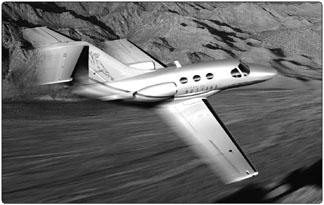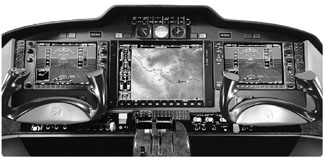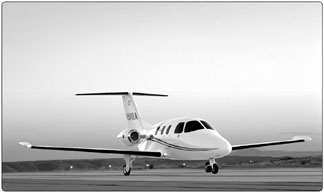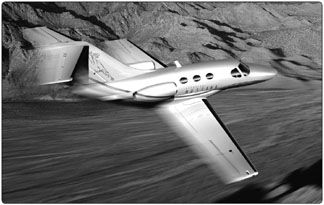
By Frank Bowlin
Itll never happen. Thats how many of us reacted to the promise of low-cost jets. We were wrong-theyre not here yet, but the ETA is short. Cessna labels the Mustang an entry-level jet and Eclipse uses very light jet, or VLJ. We like the VLJ label. Multiple VLJs are nearing certification, some priced well under $2 million. Since a new Beechcraft Baron 58, a non-pressurized, normally aspirated piston twin, costs more than $1.1 million, these prices for a pressurized jet with all the latest equipment will seem very attractive-and affordable-to some.
But, what about a pilots ability to safely operate such a complex, high-speed, high-altitude aircraft? What training is necessary and how difficult will be the transition from, say, a King Air, MU-2 or even a Baron? To borrow a phrase, This isnt your fathers Bonanza.
The Market
The VLJ target market includes owner/pilots, air taxi businesses carrying people and freight and fractional operators. Part 135 and fractional operations are under more FAA scrutiny than Part 91 and have their own issues-well concentrate on owner/pilots.
Just because a GA pilot can afford and justify a VLJ doesnt mean they should fly it. Flying a high-performance single is about as much like flying a jet as driving a minivan is like riding a motorcycle. Same idea, but the devil is in the details.
The Details
You can learn the aircraft in ground school and even learn to fly it well in the simulator. However, operating competently in hard IFR in busy Class B airspace while blasting along at 250 knots simply requires lots of experience. We cant over-emphasize how important this is. It simply cant be taught-like sex, it just has to be experienced and practiced to gain proficiency and overcome mistakes, and the consequences can be just as embarrassing. Or worse.
While the transitioning pilot is gaining this experience, they often miss radio calls, bust altitude, heading or airspeed assignments and misinterpret procedures, while never quite getting complete situational awareness. When 1500 miles from home, its not only difficult to recognize the fixes, its tough to even spell them to get them programmed. Controllers usually minimize demands on a 172, but when youre playing with the big dogs, dont expect mercy.
We were surprised the issue of learning to fly these aircraft in the system isnt stressed by the manufacturers we interviewed, with only Eclipse giving it much attention. Adam Aircraft is even considering a pilot rating system of varying approach minima based on demonstrated proficiency. We think this is a bad idea. We feel strongly that the only acceptable training wheels for a jet pilot are further training, experience or supervision.
Most of the other challenges of the transition can be taught and safely practiced on the ground. These include transition from traditional round instruments to fully integrated electronic flight information systems, or EFIS. One candid pilot has been quoted describing the first time he beheld the wonders of EFIS by saying, Now I know how a dog feels when its watching television.
On closer inspection, however, we can recognize some of our old friends like attitude and heading. But some of the other displays may be so altered that we have to search to find them-data like airspeed and altitude are often presented in moving strips that can be initially confusing and can even induce the wrong initial control inputs. Mastering the avionics and instrumentation suites in these aircraft can take time, but can be done in training. Mike Fuhrman of Cessna stressed that an advantage of these systems is heightened situational awareness, and we agree.

A jet has complex systems with redundancy. The good news is that system management is largely automated. The bad news is that automation sometimes fails and the abnormal procedures can get busy. Also, as one pilot put it, You have to know the automation inside and out. If you get behind it or start to fumble in busy airspace, youre totaly screwed. Again, study can provide proficiency.
Then theres the whole issue of staying ahead of an aircraft with vectoring and initial approach speeds over 200 knots, with the occasional request to maintain 250 indicated to the marker. Yes, the aircraft will go slower, but ATC may not allow you the comfort of operating your VLJ in a terminal area at speeds more appropriate for your Baron.
None of these are barriers, but they are challenges that need to be met by the right training.
Trainings Long Path
Some cynics have said that if the FAA doesnt kill GA, insurance will. In the last decade weve seen GA insurance change from reasonable and available to a model of aggressive risk management. Today, insurance requirements on pilot experience and training are much higher than the FAAs, and they keep going up.
So, the issue isnt really training, its insurance. The insurance companies are setting the standards, and the VLJ manufacturers are working with the insurers to develop acceptable training. Eclipses Andrew Bloom put it this way: We recognize were the first and safety is our top concern.Weve set the training bar very high to meet those safety requirements.
The training program basics for each manufacturer are similar, but there are variations in details, including venue: Eclipse is developing a custom training program with United Airlines training, while David Thompson of Adam Aircraft said they are building an internal training department to better control content and quality. Cessna has used Flight Safety for their factory training for years, but has not yet selected a Mustang training partner.
The minimum realistic qualification is a multi-engine Private ticket with Instrument rating, and solid and current instrument skills. We dont just mean a recent IPC, but the kind of proficiency you get from a couple dozen approaches to minimums and lots of procedures, all to ATP standards. Because they are jets, these aircraft will require type ratings. Expect to be evaluated. Expect required additional training and/or experience to meet deficiencies.
There will be computer-based self study on turbine transition, high-altitude operations, single-pilot CRM, systems, avionics, etc. Each pilot will complete a detailed experience and skills assessment. Each manufacturer has different levels of transition training that range from a pass based on qualifications to additional training classes, some including flight time.
Next will be the actual type rating training that with some of the programs begins with a pass/fail test on systems. This five- to eight-day class will be intense preparation for the type-rating checkride. Owners failing the checkride can obtain additional training, substitute a different pilot or walk away.
After the type rating, many pilots will be required to fly with a mentor in all kinds of weather at the busiest airports. The goal here is proficiency, not time, and will typically require at least 25 hours up to 100 hours for a GA pilot with little prior experience. Then, possibly back for a proficiency check, at which point you may be approved to fly the airplane by yourself. In fact, possibly only by yourself, for perhaps 25 more hours. Only after all that will you finally be insured to fly your VLJ single-pilot with passengers.
Keeping Your Edge
Once youve met all the requirements to fly your VLJ, youve got to remain qualified. For a typical GA pilot, 100 hours a year is a lot but probably not enough to maintain proficiency to safely operate a VLJ.

Interestingly, two of the pilots we interviewed each fly about 150 hours per year. One of them said it was barely enough to stay sharp in the airplane; the other said it wasnt. Based on that, wed put the minimum annual flight time necessary to remain proficient at no lower than 150 hours a year; 200 is better.
Just like an airline pilot, youll be required to obtain refresher training every six to 12 months, depending on experience. Some companies, Adam Aircraft for instance, will also provide quarterly self-paced computer-based training like the airlines.
Conclusion
If the market develops as manufacturers hope, VLJs will be affordable and available to a wider range of pilots. In many ways, the planes will be easier to fly, as long as youre able to master the automations intricacies and think ahead of the airplane. Thorough training, mandated by insurance, will allow us to learn the airplane and how to fly it. The biggest challenges will arise in gaining comfort within the busiest airspace and worst weather.
Once you do all that, though, theres nothing that can beat the pride and satisfaction of your first solo flight at FL410.
Also With This Article
“The Thurman Munson Accident”
“Its The Automation, Stupid”
“Thinking On Your Feet”
-After 30 years in the computer industry, Frank Bowlin is now a pilot for a large regional airline and an independent flight instructor.




